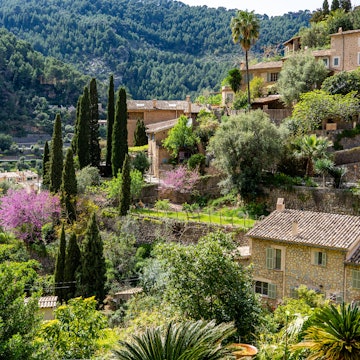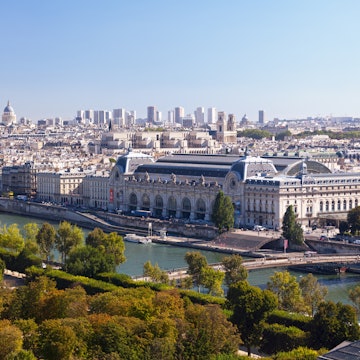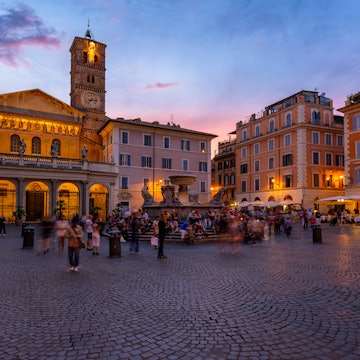
Two blissful weeks on the water from Dubrovnik to Split
Sponsored by
Nov 9, 2020 • 6 min read

Trogir’s waterfront promenade encapsulates everything great about sailing the Dalmatian coast of Croatia © Ivo Biočina / Croatian National Tourist Board
There’s something special about traveling the waters of the Adriatic, and this itinerary through extraordinary southern Dalmatia, from Dubrovnik to Split, is one of Europe’s most rewarding coastal journeys.
At one end, Dubrovnik, surely one of Europe’s most enchanted cities. At the other, Split, an elegant city with Roman splendour at its core. And everywhere in between, Dalmatia’s natural beauty, historic villages, and fine foods make for a wonderful, uplifting antidote to the dark horizons that have cast their pall over the travel landscape in the wake of the coronavirus pandemic.
Traveling by water – whether by ferry, cruiser, or sailboat – slows you down to a pace perfectly suited to the rhythms of island and coastal life. And while you can complete this itinerary at any time of the year, there is no better time than the fall when visitor numbers are fewer and island forests turn golden.

Elafiti Islands
When you can finally tear yourself away from Dubrovnik’s historic architecture and superb natural setting, you’ll be surprised at how quickly the crowds and clamor recede as you sail out into the Adriatic, bound for the Elafiti Islands. Sailing between these 14 islands, just three of which are inhabited, means leaving the crowds behind to seek out private coves accessible only by sea.
The closest of the islands to Dubrovnik, Koločep is like an Adriatic stereotype given life. Carpeted in forests of ancient pines, speckled with citrus orchards and olive groves, Koločep has sandy beaches and very few people. It’s the perfect place for a picnic.
Not far away, Šipan, the largest of the Elafiti Islands, was long the favoured retreat for the well-to-do of Dubrovnik society, and it’s not difficult to see why. Mansions line the waterfront and the pretty small towns – Suđurađ, with its stone houses surrounding a harbor, or Šipanska Luka with a ruined Roman villa and medieval duke’s palace – can seem like mini Dubrovniks.
Best of all, the isle of Lopud is car-free, filled with stone buildings, fragrant gardens, and haunting fortresses. If you’re sleeping on your boat, you’ll fall asleep to the gentle rocking of calm Adriatic waters.

Mljet
If the Elafiti archipelago is impressive, Mljet, a short sail away to the northwest, is utterly spectacular. Everything about this place carries a whisper of legend, from the forests that muffle all sounds from the outside world to a history filled with Romans, Byzantines and the other great civilizations who left their mark. Myths even claim that Odysseus fell in love with Mljet and couldn’t bear to leave for seven years.
All of western Mljet is a national park, a sublime, peaceful world with tidal saltwater lakes and gorgeous forest trails. Near-perfect swimming spots, an island Benedictine monastery, the smell of fresh air and pine needles – we know why Odysseus stayed so long.
There is so much to turn your head in Polače, one of the larger villages on Mljet, with fifth-century ruins, a fort, and a church from the region’s earliest days of Christianity. But it’s to the island’s quietly beautiful west that you’ll keep on returning. Sailing along this undeveloped shore means surrounding yourself with deep blues and greens as you soak up the pleasures of traveling by boat.

Korčula
It just keeps getting better the further northwest you sail. As you cross the waters that separate the islands, enjoy the views – of uninterrupted Adriatic horizons out west, and silhouetted along the coast and neighboring islands.
Korčula has it all. Its old town alone could just be the Adriatic’s most charming, a beguiling combination of timeworn fortifications, marble streets, medieval churches, and terra cotta-roofed buildings surrounding a pretty harbor – sailing into this harbor at any time of day is one of the prettiest arrivals imaginable.
Wines from Korčula – especially the whites made from the local pošip grape around the villages of Čara and Smokvica – are probably Croatia’s best. Enjoy them in a rural vineyard or in a Korčula restaurant serving traditional dishes such as brodet (a slightly spicy seafood stew served with polenta) or pašticada (beef stewed with wine, prunes and spices and served with gnocchi).
And you’ll love the island’s thick pine forests, olive groves, quiet harbors, and pebbly beaches; the island’s loveliest beach is Pupnatska Luka, on Korčula’s south coast.

Vis
By the time you reach Vis, you’re well-acquainted with so many of the joys of traveling along Croatia’s Adriatic coast – fine local wines and food, medieval fortress towns encircling a small harbor, forests that change color with the seasons. Vis has all of these, not to mention the quiet revelation that you can only enjoy if you’re arriving by boat.
Vis carries a real sense of having been cast adrift into the Adriatic – no other inhabited Croatian island lies further from the mainland. Whether you’re exploring the island’s southern and eastern beaches – Stiniva and Srebrna, Milna and Zaglav – you’ll feel as if you’ve stumbled upon your very own Adriatic idyll. Some can only be reached by boat, which only adds to the feeling of being far from the world and its noise. And if you’re lucky enough to sleep aboard your boat, soak up the silence as night descends.

Hvar
If Vis is Dalmatia’s quiet alter ego, Hvar is its beating, hedonistic heartland – here you’ll arrive in one of Dalmatia’s busiest harbors. One of southern Dalmatia’s busiest and most popular tourist islands, Hvar draws partygoers throughout the summer, luxury hotels line parts of the coast, and the island enjoys more annual sunshine than anywhere else in Croatia. But social distancing becomes easier in the fall as crowds diminish, allowing you to explore on foot the tangle of historic streets that rise from the water’s edge.
Better still, beyond the main settlement you’ll encounter deserted stone-hewn villages, jagged hills, vineyards, and fields of lavender. And if you spend time exploring the south coast, sailing past deserted inlets and otherwise-inaccessible beaches, you’ll wonder whether rumors of Hvar and its crowds were invented by locals to keep these secrets all to themselves.

Brač
You’re nearing the end of this wonderful journey, and the island of Brač promises one last island paradise before you return to the mainland. Brač is famous for its distinctive white stone and there is no more magnificent sand beach in Croatia than Zlatni rat, a narrow, perfectly proportioned tongue of white sand that reaches out into the turquoise sea.
For those eager to do more than relax on the sand, go beyond dipping your toe into the water – windsurfing, parasailing, stand-up paddleboarding, sea kayaking, boating, and diving are all possible here.

Trogir
Split is calling, and its appeal can be difficult to resist. But before you return to the big city and all that it offers, sail from Brač to UNESCO World Heritage-listed Trogir.
Enclosed within medieval walls, inhabiting its own island, Trogir is a tightly packed huddle of stone and terracotta. As you approach from the water, it resembles an extension of the coastline with its earth tones and karst colors, the uniform skyline broken only by the spire of the remarkable Venetian cathedral. On land, you’ll wander atop shiny marble paving stones amid an astonishing forest of Romanesque and Renaissance buildings. Trogir is a film set, an evocation of medieval perfection, a perfect place to end your southern Dalmatian odyssey.
All the ingredients that you know so well are here – beaches, water-borne activities, architectural intrigue, fine foods, history written in the stones. But having traveled so far, perhaps your favorite moment will come along Trogir’s waterfront promenade, looking out across the Adriatic that you’ve come to know so well.
You might also like
Why food and culture fans need to explore inland Croatia
Responsible outdoor excursions in Croatia this fall
Sponsored by Croatian National Tourist Board
As a travel entertainment and inspirational media outlet, we sometimes incorporate brand sponsors into our efforts. This activity is clearly labeled across our platforms.
This story was crafted collaboratively between Croatian National Tourist Board and Lonely Planet. Both parties provided research and curated content to produce this story. We disclose when information isn’t ours.
With sponsored content, both Lonely Planet and our brand partners have specific responsibilities:
-
Brand partner
Determines the concept, provides briefing, research material, and may provide feedback.
-
Lonely Planet
We provide expertise, firsthand insights, and verify with third-party sources when needed.















